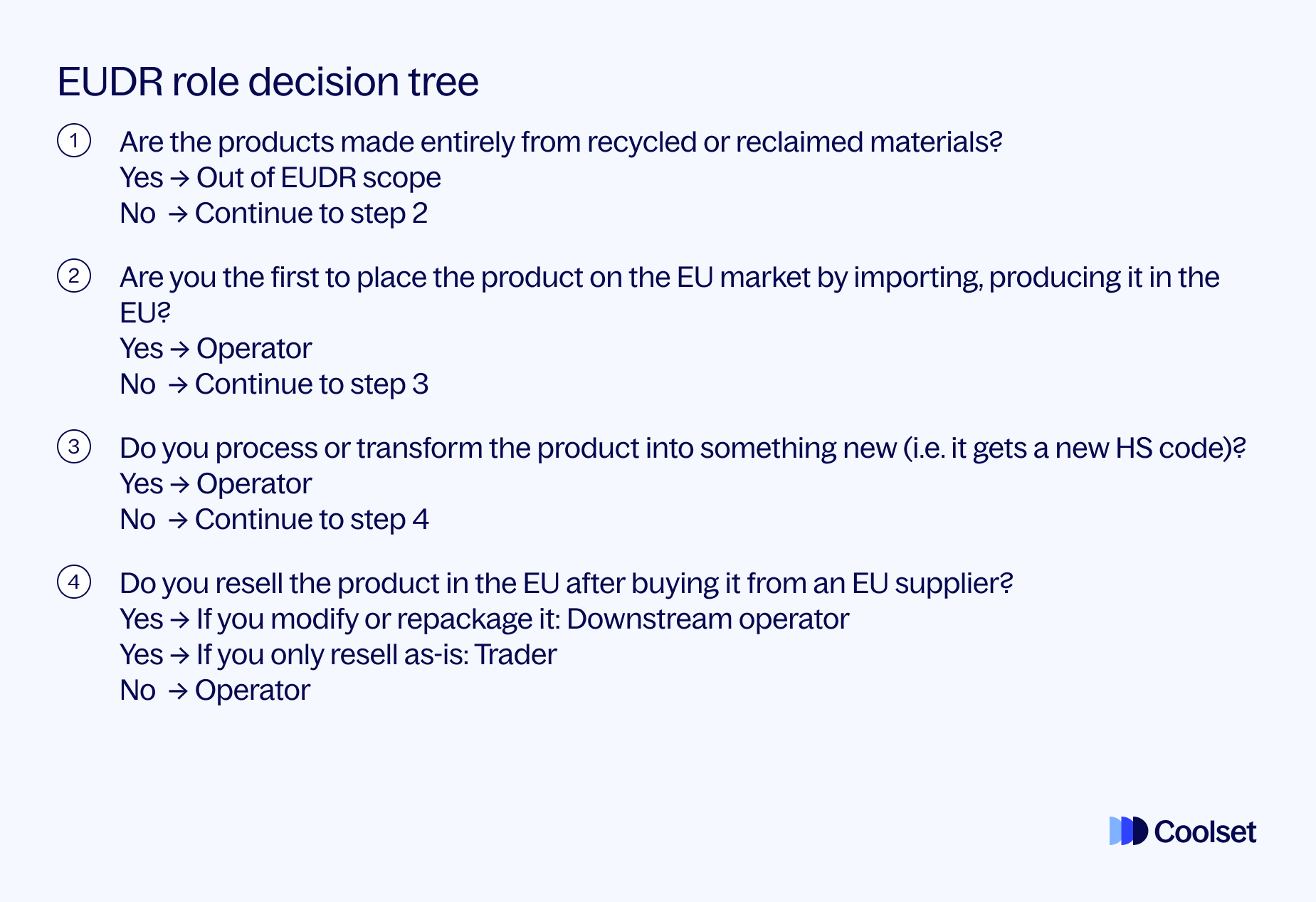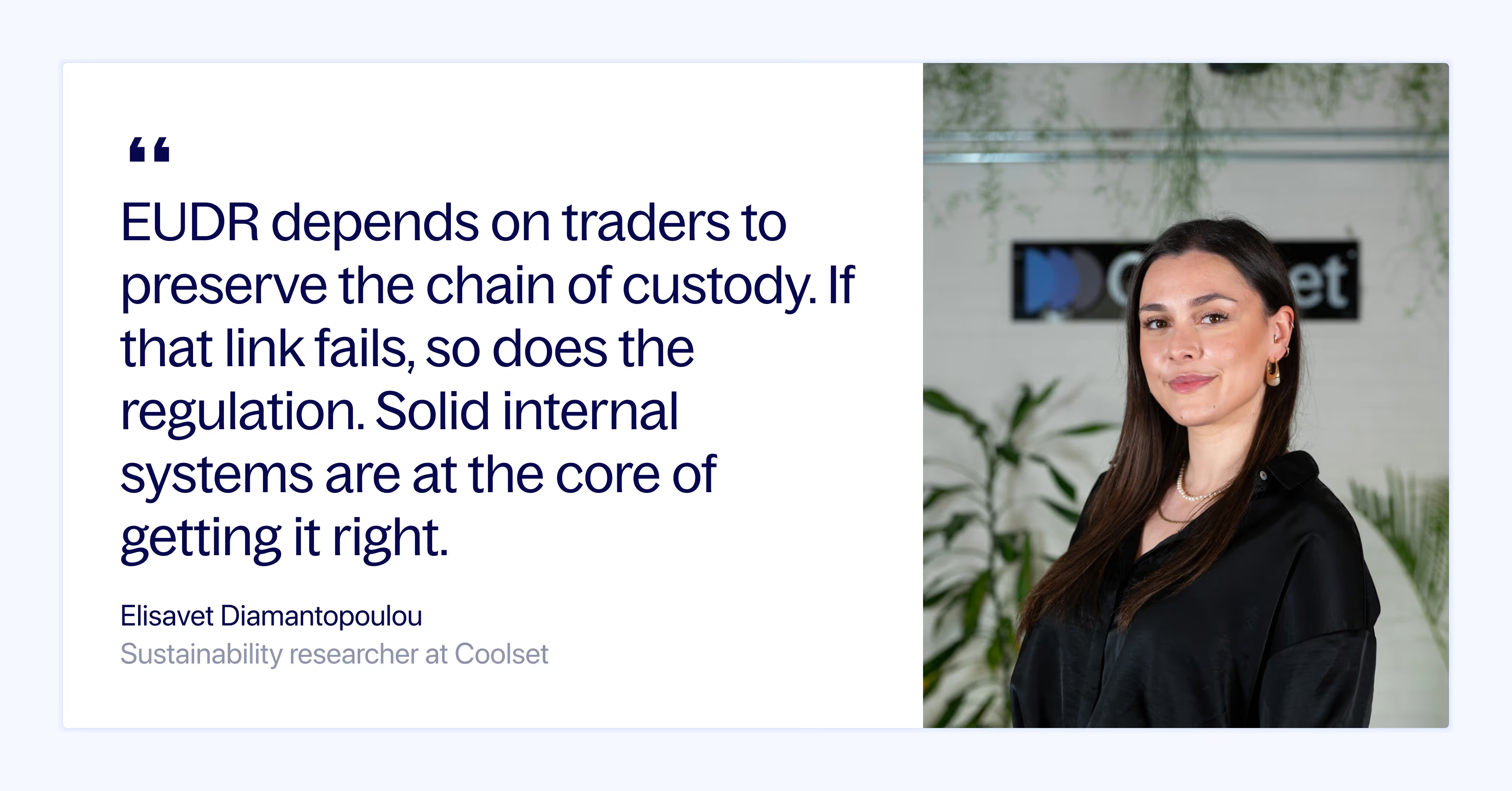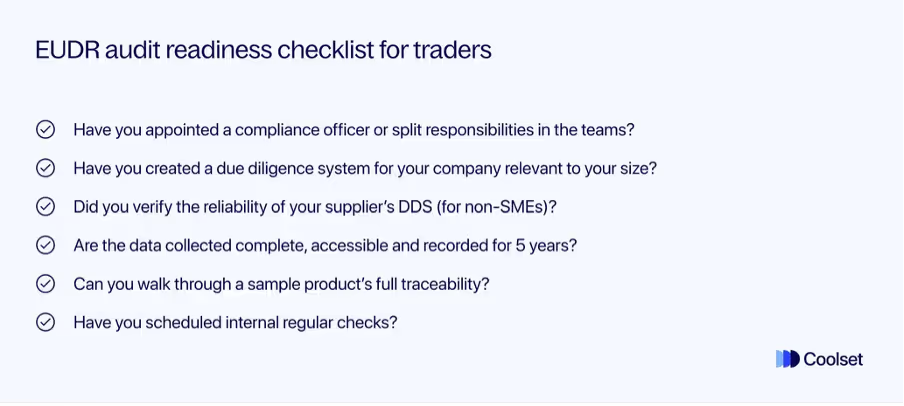Disclaimer: Latest EUDR developments
On 21 October, the European Commission proposed targeted changes to the EU Deforestation Regulation (EUDR). These adjustments aim to make the rollout smoother without changing the regulation’s overall goals.
Key points from the proposal:
We're closely monitoring the development and will update our content accordingly. In the meantime, read the full explainer here.
The EU Deforestation Regulation (EUDR) is a new law aimed at fighting deforestation by ensuring that certain commodities and products are deforestation-free and legally produced.
For traders - businesses that buy and resell products within the EU without transforming them - EUDR compliance is scheduled to begin on 30 December 2025 for large and medium-sized companies, and 30 December 2026 for small and micro enterprises - as outlined in the European Commission's latest EUDR proposal, which is pending approval by the Parliament.
Traders play a crucial role in this system, bearing the responsibility to maintain and pass on traceability information across the supply chain. Their role is even more critical given how fragmented commodity markets are, often involving multiple layers of intermediaries before products reach the end market. In this guide, we break down what EUDR means for traders and outline practical steps from identifying your role to preparing for audits to help you meet the new requirements.
Under EUDR, traders are defined as companies making available in-scope products in the EU market after they have already been placed on the market by someone else. In simple terms, if you buy and sell regulated commodities within the EU (without being the first importer, producer, exporter or manufacturer), you are a trader. The difference lies in your role in the supply chain. Operators handle the initial entry of goods (as defined in HS codes), whereas traders handle goods after that initial entry (typically as distributors, wholesalers, or retailers sourcing from EU-based suppliers).
To illustrate, here are two real-world examples of traders:
Here is a practical checklist to check if you are considered a trader or operator under the EUDR.

Even though traders don’t carry the full due diligence process that operators do, EUDR still places important reporting and traceability obligations on them. The exact responsibilities vary depending on your company’s size.
If you’re not a SME, EUDR effectively treats you similar to a downstream operator. In fact, non-SME traders have the same core obligations as large operators.
Your responsibilities in a nutshell:
However, non-SME traders may benefit from a simplified form of due diligence. If you can ascertain that your upstream supplier has conducted proper due diligence, you can reuse and reference their DDS in your own submission. Even when referencing an upstream DDS, you remain legally liable if the due diligence was incomplete or incorrect, so it’s in your interest to assess suppliers carefully and document why you trusted their DDS.
EUDR offers small traders a lighter load. SME traders are not required to conduct due diligence or submit their own DDS as long as the product was already covered by a DDS. However, they have critical traceability responsibilities.
In a nutshell as an SME trader you must:
In essence, the law expects small traders to preserve the chain-of-custody information. If an SME trader suspects that a product might not be compliant (for example, if proper documentation is missing or there are red flags), they are obligated to notify authorities immediately.
No trader, regardless of size, is allowed to knowingly deal in non-compliant goods. Selling a product you know (or should know) is linked to illegal deforestation would violate EUDR.
Traders essentially serve as the compliance bridge in the supply chain: by the time a product reaches an end user, there should be a clear digital trail back to a compliant source. This means robust record-keeping and the ability to produce documentation upon request.
{{custom-cta}}
To learn more about the EUDR requirements for SMEs, check our reporting guide for SMEs.
In October 2025, the European Commission proposed amendments that would align the responsibilities of non-SME traders, SME traders, and downstream operators under the same simplified framework. Under this proposal, both non-SME and SME traders, as well as downstream operators, would have the same core obligations:
They would no longer be required to submit their own DDS, even if they are non-SMEs, as long as the upstream operator has already filed one. The reasoning behind this change is to reduce duplication and administrative burden, ensuring that fewer DDS are submitted for the same product across the chain, which in turn prevents overloading the TRACES information system while still preserving full traceability throughout the supply chain.
Complying with the EUDR as a trader involves a mix of verification, documentation, and internal coordination. Below is a step-by-step guide tailored for both SME and non-SME traders, with notes on what can be skipped by SMEs.
Start by verifying that you’re acting as a trader. Then confirm whether you qualify as an SME under the EUDR definition. This distinction is critical: SMEs have limited obligations, while non-SME traders must follow due diligence steps similar to operators. This determines which of the next steps apply to you.
List all products and commodities you trade and check which ones fall under the EUDR scope. Then, map your supply chain for those products. Understand who your suppliers are, where the products come from, and what your upstream supply chain looks like. This foundation is key to traceability, managing risks of non compliance and audit readiness.
Your internal systems should match your size and obligations
Non-SME traders need to establish a documented due diligence system, including:
SME traders don’t need a formal system but must have a clear, accessible way to:
Non-SME traders must “ascertain” that due diligence was properly conducted by their supplier but the law doesn’t define exactly how to do this. We recommend conducting a supplier maturity assessment to evaluate their EUDR readiness.
Key non exhaustive criteria include:
This assessment helps you decide whether to trust and reuse the supplier’s DDS or dig deeper. If the maturity assessment cannot provide sufficient confidence that the supplier’s due diligence was properly conducted then we recommend continuing with the full process and carry out a proper due diligence yourself.
All traders need to collect data, but the scope depends on your size. Regardless of your company’s size you must collect data on:
If you are a non-SME trader reusing an upstream DDS, in addition to the above, you need to collect:
Before you sell a product, you must submit a DDS via the EU’s Information System. If you’re reusing a supplier’s DDS, you will reference it in your own DDS, vouching for its credibility.
Traceability is at the heart of EUDR. Whether you're an SME or not, you must be able to track every product you trade back to its origin and prove it.
Here’s what that looks like in practice:
Tip: Build your system around “trace-back” logic. Ask yourself: if someone picked this product off a shelf, could you trace it all the way back to the farm or forest where it was grown or harvested?
For SME traders, setting up a traceability system can be relatively straightforward. A well-organized database is often enough as long as it clearly links supplier names, DDS references, and product batches.
However, for non-SME traders, the scale and complexity of operations typically require a more structured approach. Larger businesses may need to adopt dedicated supply chain or compliance software that connects products with their corresponding DDS and if needed geolocation data, and supporting documentation in one centralized system.
Important: Remember that you must store all traceability records for at least five years, and be ready to share them if requested during an audit.
EUDR audits aren’t hypothetical, they’re part of the enforcement plan. As a trader, being prepared means knowing where your documents are, how to access them quickly, and showing that your systems work in practice.
Here’s what authorities will typically check:
For non-SME traders, audits will also look at your due diligence system so keep it documented and updated. For SMEs, the focus is on traceability: as long as you can provide the right supplier and DDS information, you’re on solid ground.
Tip: Use audit preparation as an opportunity to improve your internal processes. The better your documentation flows today, the easier compliance will be tomorrow.
The European Commission has proposed updates that may significantly reduce obligations for non-SME traders. If adopted, non-SME traders will no longer need to submit their own due diligence statement (DDS) if the product is already covered by an upstream DDS. This means that steps 3,4 and 6 of the current set up would be reduntant. At the same time, step 5 would be reduced to a single key responsibility, collecting, storing, and passing on DDS reference numbers or declaration identifiers from your upstream suppliers. The proposal is under review by the European Parliament and Council and is not yet legally binding. Until finalized, traders should continue preparing under current rules.

Even well-intentioned traders can stumble when it comes to EUDR compliance. Below are some of the most frequent misconceptions we’ve observed along with practical ways to avoid them.
Assuming that suppliers are fully compliant without conducting your own checks can be detrimental. EUDR places the responsibility on each company to ensure that the products they trade are deforestation-free and legally sourced.
How to avoid it: Implement a supplier maturity assessment to evaluate the reliability of your suppliers' due diligence processes. This includes checking for past compliance violations and ensuring that documentation is available, complete and credible.
Important:
Based on the October 2025 proposal, traders, both SME and non-SME, would no longer be required to assess or verify their suppliers’ due diligence processes.
Under the proposed amendments, once an upstream operator has submitted a valid due diligence statement (DDS) or declaration identifier, downstream traders can rely on that record without performing additional checks or maturity assessments.
Even after you have assessed your supplier’s reliability, relying solely on the data they provide without independent verification can still be risky. Blind trust isn't enough; traders must actively confirm the accuracy and completeness of the data received.
How to avoid it: When reusing a due diligence statement, perform spot checks on the data it contains. This may include verifying coordinates, checking document consistency, or requesting clarifications from the supplier where needed.
Important:
Based on the October 2025 proposal, traders would be allowed to trust the due diligence statement (DDS) or declaration identifier received from their suppliers without performing independent verification or spot checks. However, even under this simplified approach, it remains good practice to validate the DDS information you receive. Tools like Coolset’s EUDR compliance software can help you automatically verify that a DDS number is legitimate, active, and correctly linked to the specific products or shipments you purchased, adding an extra layer of assurance and helping to flag mismatches or expired records before they become compliance risks.
Some traders mistakenly believe that being classified as an SME exempts them from all EUDR requirements. While SMEs have reduced obligations, they are still required to maintain traceability and provide information upon request.
How to avoid it: Regularly assess your company’s capacity to collect and share EUDR-related information. Even as an SME, you must retain key records and be ready to prove traceability at any time.
Disorganized or missing records can lead to compliance failures. EUDR mandates that traders maintain detailed records of their supply chains, including supplier identities, due diligence statements and transactions history for at least five years.
How to avoid it: Utilize digital tools to automate data collection and storage. Make sure each product is clearly linked to its DDS and supplier. Keep files easily retrievable for audits
Non-SME traders sometimes assume they will face lighter oversight than operators. On the contrary, EUDR explicitly treats non-SME traders as equivalent to operators because of their significant influence in the market
How to avoid it: If you're a non-SME, treat EUDR compliance with the same level of depth as a downstream operator would. This includes maintaining up-to-date records and ensuring all compliance measures are thoroughly followed and documented.
Important:
Even though the October 2025 proposal would reduce obligations for non-SME traders, you will still be required to maintain full traceability records, pass on DDS or declaration identifiers, and cooperate with audits by competent authorities. Simplified duties do not remove oversight, traders must remain audit-ready and able to prove continuous traceability
EUDR compliance doesn’t end when you’ve collected documents or filed a DDS. Audits are a key part of enforcement and being prepared means building internal processes that reflect your responsibilities and can stand up to scrutiny.
Here are the key actions traders should take when preparing for an EUDR audit:
Start by making EUDR compliance someone’s job or several people’s. Appoint an overall EUDR lead or compliance officer but also make sure to involve key teams where relevant. For example the following teams are usually playing a crucial role in implementing EUDR:
Shared responsibility keeps compliance embedded across your business not siloed in one team.
Do not assume compliance will happen without any changes. Set up an internal due diligence system that reflects your obligations based on the steps above. Non-SME traders must have a documented due diligence system, including data collection, supplier assessment, recordkeeping, and DDS submissions. SME traders need a clear traceability process even without submitting DDS, you must store supplier info and DDS references and be able to retrieve them on request.
Auditors will typically focus on five key areas. First, they’ll check your recordkeeping. Are your documents complete and accessible? Second, if you’re a non-SME, they’ll assess how you “ascertained” that your upstream supplier’s DDS was credible. Third, they’ll look at whether your due diligence system (or traceability system, for SMEs) is actually in place and functioning. Auditors may also review a few sample orders, asking you to walk through the compliance journey of a product from end sale back to origin.
Create a central repository whether it’s a compliance platform, an ERP function, or a structured folder system where each document is clearly labeled and linked to the relevant product and supplier. Backup everything and ensure all records are retained for at least five years. If someone leaves your team, your audit trail should still be intact.
Simulate audit scenarios quarterly or bi-annually where you:
These dry runs can build confidence and surface weaknesses before an actual inspection.
Audit preparation isn’t a one-time effort. If you identify weak points during internal reviews, like inconsistent supplier data or gaps in file storage, and fix them right away. If your company is growing and approaching the SME threshold, start planning to implement a full due diligence system. The best time to strengthen your process is before an audit notice arrives.
Use this short checklist to review your EUDR audit readiness and ensure nothing slips through the cracks.
The European Commission’s latest proposal (October 2025) includes simplified obligations for non-SME traders -removing the need for them to submit due diligence statements (DDS) if upstream operators have already done so. However, traceability, registration, and data-sharing requirements remain. These changes are not yet in force. Until formally adopted, traders should follow current obligations as outlined below:

Traders are more than just intermediaries in the supply chain, they’re essential links in ensuring that EUDR compliance holds from origin to end market. In many cases, products pass through multiple traders before reaching their final destination. That means the responsibility to maintain and pass on traceability often rests with you.
The regulation makes it clear: every actor must play their part to keep deforestation‑linked commodities out of the EU market. For traders, this now means storing and sharing the right data, passing on DDS reference numbers, and keeping records organized and accessible for audits.
This is where digital tools can make all the difference. A well-designed system can connect your shipment data with product details, supplier and buyer information, and due diligence records all in one place. It simplifies how you track, store, and retrieve compliance documents. It also ensures you can send the right information downstream or present it during audits without delay or confusion.
Coolset’s EUDR module helps traders and operators manage traceability efficiently. It centralizes product, supplier, and buyer data, tracks DDS references from upstream operators, and maintains complete, audit‑ready traceability records without relying on spreadsheets or email chains. The system automatically flags missing data or documentation gaps and ensures you’re prepared for regulatory checks at any time.
Reach out to our team and see Coolset EUDR module in action.
Get a practical introduction to the EUDR and its key requirements.

Track shipments, trace origins, and submit due dilligence statements with an EUDR compliance software built for operators and traders.
